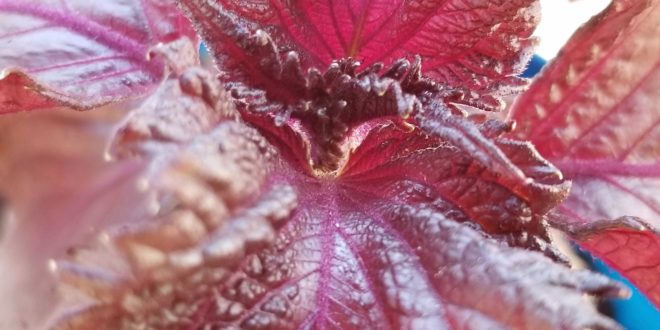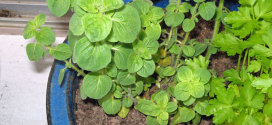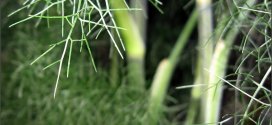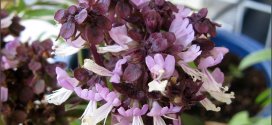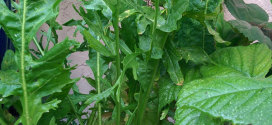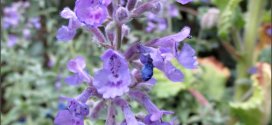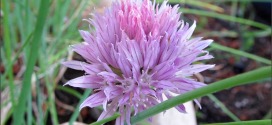Shiso (Perilla frutescens) is a staple in both sushi rolls and ornamental gardens. An annual warm-season herb, it flourishes in part shade or sun, with the level of sunlight intriguingly affecting the colors of its leaves. Perilla in sunny garden beds tends to bear burgundy leaves, while those in part shade develop light green foliage. In Sunnyvale, set seeds or seedlings into the garden any time between April and June.
Shiso is in the mint family Lamiaceae. It is native to Southeast Asia and Indian highlands, and is traditionally grown in the Korean peninsula, Southern China, Japan and India as a crop. Perilla is a very attractive plant for the garden and attracts butterflies. It is an aromatic plant with a strong minty smell.
Names
In the USA, the plant is known by many names such as perilla mint, beefsteak plant, purple perilla, Chinese basil, wild basil, blueweed, Joseph’s coat, wild coleus and rattlesnake weed.
In Korean, the name kkae (깨) refers to both the plant and the seed of sesame and perilla. Sesame is called chamkkae (참깨; literally “true kkae”), while perilla is called deulkkae (들깨; literally “wild kkae”). Because of this, deulkkae is sometimes mistranslated as “wild sesame”. It is called egoma in Japanese, and sūzi or zĭsū in Chinese.
Cuisine
Use the leaves in sushi or toss them into fruit or green salads for a spicy, colorful accent.
Various perilla varieties are traditionally used by local people, the leaves are used as a vegetable and the seeds supply nutritious cooking oil. A variety of this plant, P. frutescens var. crispa or “shiso”, is widely grown and is one of the most popular garnishes in Japan, used as an antidote for fish and crab meat allergy or as a food colorant.
In Korean cuisine, kkaennip or perilla leaves are widely used as a herb and a vegetable. Kkaennip can be used fresh as a ssam vegetable, fresh or blanched as a namul vegetable, or pickled in soy sauce or soybean paste to make jangajji (pickle) or kimchi. The leaves are used as wraps for sushi, rice, and meat.
In Japanese cuisine, the perilla leaves called akajiso (赤紫蘇; “red shiso”), are used to dye pickled plums (umeboshi). They are also boiled with sugar and water to make a summertime thirst-quencher.
Growing Perilla in the ground
Conduct a soil test to determine the pH level of soil. Perilla prefers slightly acidic soil, which registers as a pH level of about 5.0 to 6.5.
Add garden-grade sulfur to the soil at the rate recommended on the package if you need to lower your soil’s pH level from alkaline to slightly acidic. If it is overly acidic, add garden lime to your soil at the rate recommended on the package.
Lay a 3-inch layer of screened compost or aged manure over your future perilla patch, and work it into the soil to a depth of about 6 inches with the spade or tiller. Although perilla isn’t demanding about soil fertility, nitrogen-rich fertilizers encourage healthy growth and larger, lusher leaf production.
Lay seeds on the soil surface about 6 inches apart in rows 36 inches apart.
Cover seeds with a 1/2-inch layer of topsoil.
Tamp the soil down with the back of a rake for good contact between soil and seeds.
Lightly water the soil’s surface with a watering can or a garden hose set to low.
Thin seedlings to a spacing of 36 inches in all directions once they emerge. Choose the hardiest seedlings to save, and cut the thinned ones at the soil line with garden scissors, rather than disturb the soil by pulling them.
Mulch around perilla plants with fine wood chips, pine needles, or other materials. Lay the mulch around the seedlings in a 2-inch layer. Keep the mulch about 3 inches from the base of the plants to discourage burrowing pests.
Keep soil consistently moist to encourage lush leaf growth.
Pinch stems every two weeks. Gently nipping off the tips of stems causes perilla to grow wide as well as tall, preventing a scraggly, “leggy” look.
Harvest perilla for cooking or floral arrangements by cutting individual stems at an angle near the base of the plant. Avoid cutting more than one-third of each plant’s foliage at one time.
Remove flowers before they set seed, unless you want to encourage reseeding. While they are not considered invasive in states such as California, perilla plants do reseed freely and can spread where you don’t want them.
Pull perillas from the soil at the end of their growing season, when they turn brown or the leaves begin to taste bitter.
Things You Will Need
- Soil test kit
- Sulfur or lime (optional)
- Compost or manure
- Spade or tiller
- Watering can or garden hose
- Rake
- Garden scissors
Tips
Soil test kits are available at garden centers and are user-friendly. Put a small sample of soil and some water in the provided test tubes, add the included powder, and match the resulting color to a color chart listing various pH levels.
If you experience chilly or foggy springs, start perilla indoors, and set out the seedling at a spacing of about 36 inches.
“Magilla Perilla,” a hybrid of Perilla frutescens, has been bred to bear showy, coleus-like multicolored leaves. For gardeners worried about self-seeding in common perilla, Magilla perilla makes a better choice because the seeds are sterile.
Warnings
While Perilla frutescens thrives in moist soils, it will die in bog-like conditions. Build raised beds over waterlogged soil, or plant perilla in pots.
Although perilla is widely cultivated as an edible and medicinal plant for humans, the plant is toxic to cattle and other ruminants, as well as horses. The plant contains ketones that cause acute respiratory distress syndrome in grazing cattle, also called “panting disease”.
